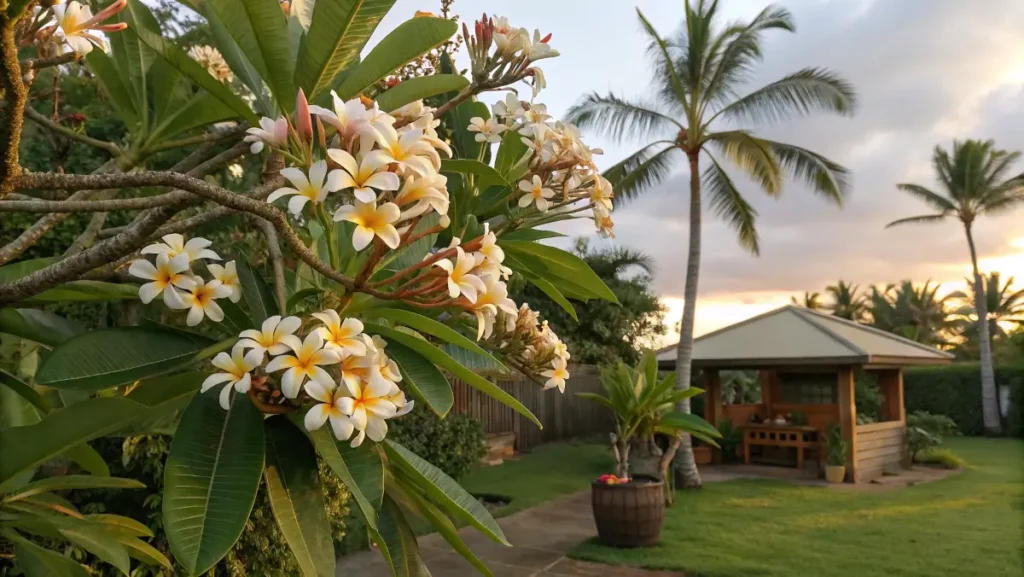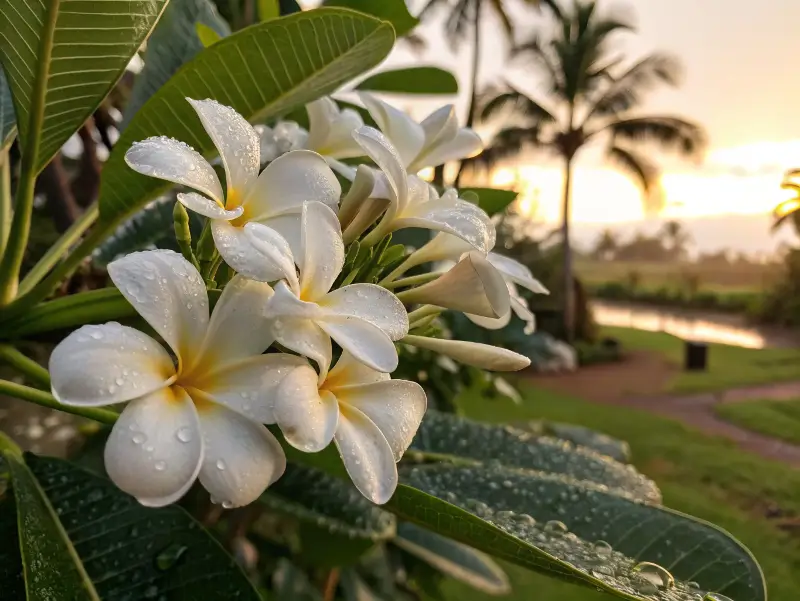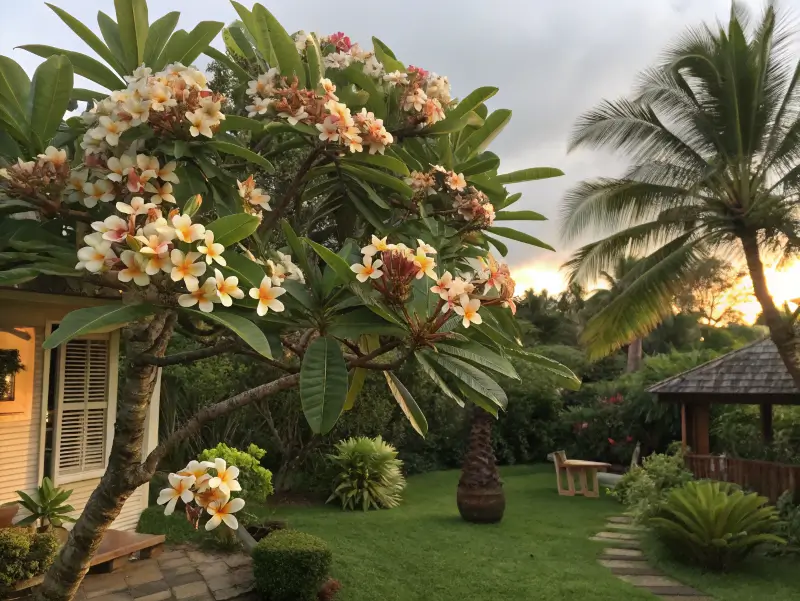
Table of Contents
Meet the Puakenikeni (Fagraea berteroana) – Hawaii’s beloved “ten-cent flower” that’ll make your garden smell like paradise! These gorgeous trees are famous for their creamy white blooms that slowly transform into golden-orange beauties, releasing an intoxicating jasmine-like fragrance. Growing at a moderate pace to about 20-30 feet, they love bright light and consistent moisture. Plus, they’re non-toxic to pets, making them perfect for family gardens seeking that tropical lei-flower magic!
Growing and Caring for Puakenikeni Trees
Ideal Growing Conditions for Puakenikeni Cultivation
Alright, let’s get down to the nitty-gritty of growing these beauties! The puakenikeni flower tree loves warm, humid conditions – think tropical paradise, not desert heat. Moreover, they prefer partial shade to full sun, though too much shade will reduce flowering.
Temperature-wise, these trees are happiest between 65-85°F year-round. Furthermore, they can handle brief cool spells, but prolonged cold will stress them and reduce puakenikeni flower production.
If you’re growing other tropical flowers like White Hibiscus Flower or Blue Hibiscus Plant, you’ll find that puakenikeni flower trees have similar care requirements, making them great companion plants.
Soil Requirements and Climate Preferences
Here’s what I’ve learned about soil – the puakenikeni flower tree isn’t too picky, but it definitely prefers well-draining soil with good organic content. Moreover, slightly acidic to neutral pH (6.0-7.0) seems to work best.
Additionally, these trees appreciate consistent moisture but can’t tolerate waterlogged conditions. Therefore, amending heavy clay soil with compost or organic matter will help create the perfect growing environment for your puakenikeni flower tree.
Key soil requirements: • Well-draining, organic-rich soil • pH between 6.0-7.0
• Consistent moisture without waterlogging • Good air circulation around roots
Watering, Fertilizing, and Pruning Puakenikeni Trees
Let me share my watering strategy – the puakenikeni flower tree likes deep, infrequent watering rather than daily sprinkling. Moreover, I check the soil moisture by sticking my finger about 2 inches down; if it’s dry, it’s time to water.
For fertilizing, I use a balanced tropical plant fertilizer (like 10-10-10) every 6-8 weeks during the growing season. Additionally, adding compost around the base helps provide slow-release nutrients that support healthy puakenikeni flower production.
Pruning is pretty straightforward – just remove dead or crossing branches and shape as needed. However, avoid heavy pruning right before flowering season, or you’ll miss out on those gorgeous puakenikeni flower displays.
Common Growing Challenges and Solutions
Honestly, the puakenikeni flower tree is relatively low-maintenance, but there are a few issues to watch for. Moreover, aphids and scale insects can occasionally become problems, especially on new growth.
Additionally, overwatering is probably the biggest mistake I see people make. Furthermore, these trees can develop root rot if the soil stays too wet, which will definitely affect puakenikeni flower production.
According to the USDA Plant Database, proper drainage and air circulation are key factors in preventing most puakenikeni flower tree problems.
Uses and Applications of Puakenikeni Flowers
Traditional Lei Making with Puakenikeni Blossoms
There’s honestly nothing quite like creating a lei with fresh puakenikeni flower blooms. Moreover, the traditional stringing method involves carefully threading the flowers to avoid bruising those delicate petals.
What I love about puakenikeni flower leis is how the fragrance develops over time – they actually smell better the day after you make them! Additionally, mixing different color stages creates beautiful visual interest in your finished lei.
Modern Decorative and Ornamental Uses
Beyond traditional leis, the puakenikeni flower has found new life in modern floral arrangements and decorative applications. Furthermore, these blooms work beautifully in tropical bouquets, table centerpieces, and even as floating decorations in bowls.
Moreover, many hotels and resorts now feature puakenikeni flower trees in their landscaping specifically for the amazing fragrance they provide. Therefore, you’re likely to encounter these beauties even if you’re not actively looking for them.
Why Puakenikeni Flowers Matter in Hawaiian Culture
Let me tell you, the cultural significance of these fragrant blooms runs deep in Hawaiian tradition. In fact, these flowers represent love, affection, and deep respect – which explains why they’re so popular in wedding leis and special ceremonies.
What’s more, these beautiful blossoms have become the unofficial symbol of Kane’ohe, where some of the most spectacular specimens grow. Therefore, if you’re planning a trip to Hawaii, you’ll definitely want to experience these amazing flowers firsthand.
Botanical Profile and Scientific Classification

Fagraea Berteroana: The Scientific Name Behind Puakenikeni
Alright, let’s get a bit nerdy here (but I’ll keep it simple, I promise!). These fragrant blooms belong to the Loganiaceae family, and the scientific name Fagraea berteroana honors both the genus and a botanist named Bertero.
Interestingly, this classification puts these flowers in the same family as some other fragrant tropical plants. However, what sets them apart is their unique flower structure and that amazing color-changing ability.
Physical Characteristics of Puakenikeni Flowers and Trees
Now, here’s what makes these blooms so darn special – they start out pure white and gradually transform into deep orange-gold colors over several days. Moreover, each flower is about an inch long with a tubular shape that’s perfect for holding that intoxicating fragrance.
The trees themselves can grow pretty tall (we’re talking 20-30 feet), but honestly, you can keep them smaller with regular pruning. Additionally, the evergreen foliage provides a beautiful backdrop for those stunning flower clusters.
Key characteristics include: • Tubular, fragrant blooms • Color change from white to orange-gold
• Evergreen, glossy leaves • Clusters of 3-7 flowers per group • Sweet, intense fragrance
Natural Habitat and Distribution in the South Pacific
Before these fragrant beauties made their way to Hawaii, the trees thrived throughout various South Pacific islands. In particular, they love warm, humid climates with plenty of rainfall – which explains why they’ve done so well in Hawaii’s tropical environment.
Furthermore, in their native habitat, these trees often grow as part of coastal forests. Therefore, they’re naturally adapted to handle some salt air and varying moisture conditions.
History and Cultural Significance of Puakenikeni in Hawaii
The Arrival of Puakenikeni Flowers in Hawaii (Late 1800s)
Here’s a cool piece of history – these fragrant blooms didn’t arrive in Hawaii until the late 1800s, brought by Polynesian settlers who recognized their value for lei making. Consequently, what started as a foreign plant quickly became an integral part of Hawaiian culture.
Moreover, the famous mother tree in Maunawili is still standing today, and many of the trees around Kane’ohe can trace their lineage back to this original specimen. Honestly, it’s pretty amazing to think about that botanical family tree!
How Puakenikeni Got Its “Ten-Cent Flower” Name
Back in the early 1900s, Hawaiian women would string individual blooms and sell them for ten cents each – which was actually a fair amount of money back then! Additionally, this pricing made the flowers accessible to both locals and tourists who wanted to experience authentic Hawaiian culture.
Interestingly, the name stuck even after inflation made ten cents seem like pocket change. Therefore, you’ll still hear old-timers refer to these fragrant beauties by their original nickname.
Traditional Uses in Hawaiian Lei Making and Ceremonies
Let me tell you, these fragrant blooms hold a special place in traditional Hawaiian lei making. In fact, these flowers are often used for wedding leis because they symbolize deep love and lasting affection.
What’s more, the fragrance of these beautiful leis can last for days, making them perfect for special occasions. However, you need to handle these delicate blooms carefully – they bruise easily but reward you with incredible beauty.
Traditional uses include: • Wedding and anniversary leis • Welcome garlands for honored guests
• Ceremonial decorations • Personal adornment for special events
Puakenikeni as the Unofficial Flower of Kane’ohe
You know what’s really cool? These fragrant blooms have become so associated with Kane’ohe that they’re practically the town’s unofficial mascot. Moreover, many of the most spectacular specimens grow in this area, creating a natural perfume that drifts through the neighborhoods.
Furthermore, local festivals often feature these beautiful flowers prominently, celebrating both their beauty and cultural significance. Therefore, if you’re ever in Kane’ohe, keep your eyes (and nose!) open for these amazing trees.
Puakenikeni Flower Characteristics and Varieties

Color Transformation: From White to Deep Orange-Gold
Honestly, watching these blooms change colors is like witnessing a slow-motion sunset. Moreover, this transformation happens over 3-4 days, giving you a chance to enjoy each stage of the flower’s life cycle.
Initially, each bloom opens as pure white with an incredibly intense fragrance. Then, gradually, it deepens to cream, yellow, orange, and finally a rich golden-orange color. Additionally, the fragrance actually intensifies as the color deepens – nature’s pretty amazing, right?
Fragrance Profile and Aromatic Properties
Let’s talk about that incredible scent – these blooms produce one of the most intoxicating fragrances in the plant kingdom. In fact, just a few flowers can perfume an entire room for hours.
The fragrance is complex, with notes that remind me of jasmine, gardenia, and something uniquely tropical. Moreover, the scent is strongest in the evening and early morning, which makes sense since that’s when pollinators are most active.
Flower Structure and Blooming Patterns
Each bloom has five petals that form a perfect tube, and they appear in clusters of 3-7 flowers. Furthermore, the individual flowers are about an inch long and have prominent yellow stamens that add to their visual appeal.
What’s interesting is that these flower clusters don’t all bloom at once – instead, they open gradually over several weeks, giving you an extended flowering period. Therefore, you’ll often see blooms in different color stages on the same tree.
Seasonal Blooming Cycles of Puakenikeni Trees
Here in tropical climates, these trees can bloom year-round, but there are definitely peak seasons. Moreover, I’ve noticed that spring and summer typically produce the heaviest flowering, especially after periods of good rainfall.
Additionally, mature trees will have multiple flowering cycles throughout the year. However, younger trees might only bloom once or twice annually until they get established.
Frequently Asked Questions About Puakenikeni
What is Puakenikeni flower in English?
The puakenikeni flower is commonly called the “ten-cent flower” in English, though some people also refer to it as the perfume flower tree. Moreover, the scientific name Fagraea berteroana is sometimes used in formal contexts.
What is the spiritual meaning of Puakenikeni?
In Hawaiian and Polynesian cultures, the puakenikeni flower symbolizes deep love, affection, and respect. Additionally, the color transformation represents life’s journey and the beauty that comes with time and experience.
What does puakenikeni lei symbolize?
A puakenikeni flower lei traditionally represents lasting love and deep respect for the recipient. Furthermore, these leis are often given at weddings, anniversaries, and other significant life events because of their meaningful symbolism.
Is the Puakenikeni tree poisonous?
No, the puakenikeni flower tree is not considered poisonous to humans or pets. However, as with any plant, it’s best to avoid eating the flowers or leaves, and always wash your hands after handling.
Conclusion and Final Thoughts
After spending years growing and appreciating the puakenikeni flower, I can honestly say these trees are among the most rewarding tropical plants you can grow. Moreover, the combination of stunning visual beauty, incredible fragrance, and deep cultural significance makes them truly special.
Whether you’re planning to grow your own puakenikeni flower tree or simply want to appreciate these blooms during your next Hawaiian vacation, I hope this guide has given you a deeper understanding of these remarkable flowers. Furthermore, the puakenikeni flower represents everything I love about tropical gardening – beauty, fragrance, and a connection to rich cultural traditions that span generations.
So next time you encounter a puakenikeni flower, take a moment to breathe in that incredible fragrance and appreciate the amazing journey these blooms have taken from the South Pacific to become one of Hawaii’s most beloved cultural treasures.
